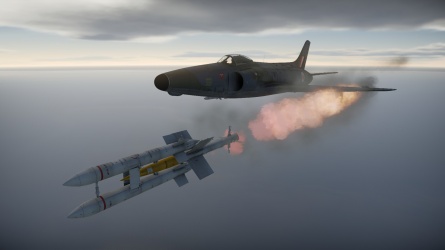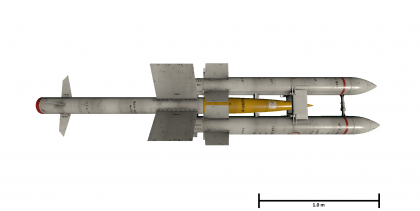Fireflash
Contents
Description
The Fireflash missile was the first air-to-air guided missile put into service with the United Kingdom’s Royal Air Force. Built by Fairey Aviation, the same company who built the Swordfish, this missile utilised radar beam riding guidance to get the missile onto a target. The odd-looking missile consists of a central dart attached to two boosters. The boosters spin-stabilize the missile in flight and propel the missile to speeds upwards of Mach 2. 1.5 seconds after launch, with fuel spent, the boosters separate and the missile would coast the rest of the way to the target, still receiving guidance from the controlling aircraft.
This missile has a very short "attention span" in that it requires the launching aircraft to basically keep the nose of the aircraft pointed at the target aircraft. The beam from the aircraft's radar will guide the missile to the target, however, the further away from the launching aircraft the missile gets, the wider the beam becomes and more difficult for the missile to continue to track. Also, if the target aircraft begins to make sudden movements, it will be difficult for the missile to keep up and sudden movements by the attacking aircraft to maintain the enemy aircraft in its sights will probably result in the missile losing the beam and it flying off until it runs out of fuel or energy and plummets to the earth.
Vehicles equipped with this weapon
General info
The main part of the missile considered the "dart" is a missile body with controllable fins, beam tracking sensors and a warhead. This portion of the missile does not have any propellent nor a motor. To produce thrust for the dart, it relies on two boosters which after firing, burn for approximately 1.5 seconds to a speed of about Mach 2, where then the boosters separate and the dart continues to be guided by the aircraft's radar beam to the target making minor adjustments as needed.
The Fireflash has a relatively short effective distance, as after separation from its boosters it no longer has a source of thrust and is reliant on its kinetic energy, once that depletes, the dart falls to the earth. Also, the farther away the dart gets from the launching aircraft, the harder time it has to maintain the beam and is likely to go astray. Quick movements of the attacking aircraft can also cause the missile to lose track of the beam and at that point, it will fly astray.
Effective damage
The Fireflash is reliant upon high explosive damage when it gets close enough to a target aircraft.
Comparison with analogues
Give a comparative description of missiles that have firepower equal to this weapon.
Usage in battles
This missile has an effective range of about 4 km (2.4 mi) before it no longer has the kinetic energy to continue. This missile is best used in short-range encounters such as head-on attacks where the enemy fighter is closing the distance rather than flying away. This missile can be used during tail chases as long as you maintain close distance and can keep the radar on the enemy long enough for the missile to acquire its target. The Fireflash is a finicky missile which requires practice and patience, though not as simple to use as other missiles found in-game, it can be a surprise to enemy fighters they are not expecting resulting in them having to go back and watching replays in unbelief to see what took them out. Having only two of these missiles to rely on will require the pilot to exercise restraint and not launch one if the chances of a hit are marginal and instead maybe turn to the 30 mm cannons instead in that instance.
| Unlike heat-seeking missiles, beam riding missiles will not trigger a missile launch warning for the enemy player. |
Pros and cons
Pros:
- Not vulnerable to countermeasures
- Do not trigger missile approach warning (MAW) systems
- Can be easier to guide than command guided missiles
- Can be used as unguided proximity rockets
- Great for head-on attacks
- Massive 20 kg warhead, third in size only to the Firestreak (22.7 kg) and Red Top (31 kg)
Cons:
- Must keep your aircraft pointing at the target
- Bad at engaging manoeuvring targets
- Anything more than gentle corrections will make missile fall out of beam and lose tracking
- Gets less accurate with increased range
- Easy to dodge if the missile is spotted
- 4 km max range then out of fuel
History
Examine the history of the creation and combat usage of the weapon in more detail than in the introduction. If the historical reference turns out to be too long, take it to a separate article, taking a link to the article about the weapon and adding a block "/History" (example: https://wiki.warthunder.com/(Weapon-name)/History) and add a link to it here using the main template. Be sure to reference text and sources by using <ref></ref>, as well as adding them at the end of the article with <references />.
Media
- Videos
See also
Links to the articles on the War Thunder Wiki that you think will be useful for the reader, for example:
- reference to the article about the variant of the weapon;
- references to approximate analogues by other nations and research trees.
External links
Paste links to sources and external resources, such as:
- topic on the official game forum;
- encyclopedia page on the weapon;
- other literature.





